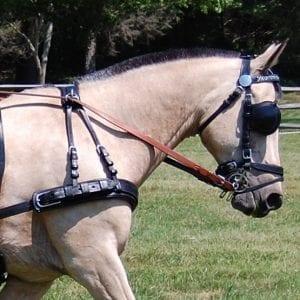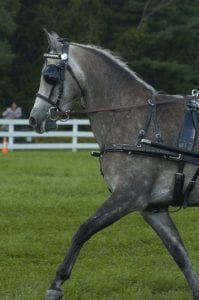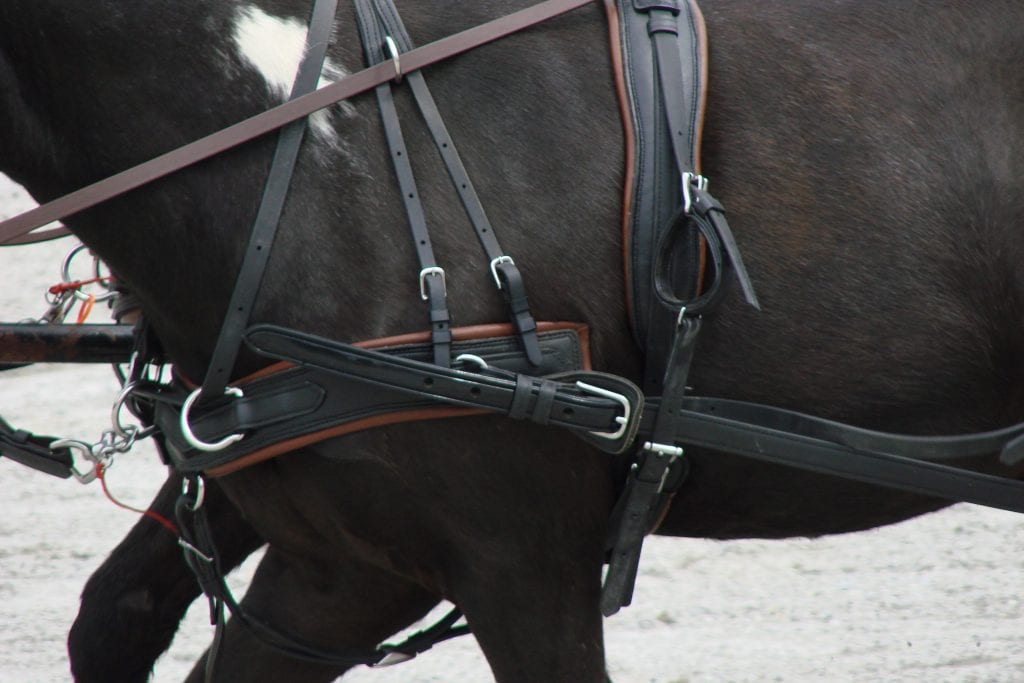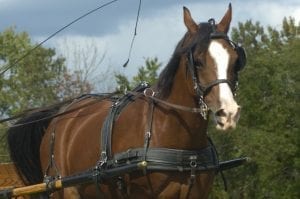
Here’s a great question that someone dropped in my inbox the other day.
They sell pads for neckstraps. Why?
Shouldn’t your neckstrap only support the weight of the breast collar? If your traces are angled too steep as with a low singletree (marathon carriage) then shouldn’t you have swivels on the collar to mitigate the downward pull where the neckstrap is involved?
If you are driving a cart, then you would want a close to level trace angle to your singletree, and if not, then the singletree should be raised or lowered, depending on the line of draft for your particular horse/pony.
I would think that, similar to the saddle, the neckstrap is a stabilizing portion of the harness, not meant to bear significant weight. Can you confirm my opinion or, if I am mistaken, please explain this for me.
Thank you.
Love your progressive cones patterns/exercises. They have helped pony and me tremendously!
Elfie Powell
Short Answer
The neck strap of a breast collar usually bears some weight when the horse is in draft. Even when hitched to a road cart with horizontal traces, the neck strap still has to stabilize the breast collar. When it does that, there’s going to be some weight placed into the neck strap.
In many light two wheeled carriages, the traces are almost completely horizontal from the breast collar. So you might say that the angle of draft is just a few degrees below the horizontal. In that case, there is little to no pressure on the neck strap.
In the photo below, the approximate horizontal is shown in read. The breast collar, traces, and singletree are highlighted in green. The traces make a very slight departure from the horizontal line. You can see the neck strap in blue is showing some slack in the rear strap, a good indication that there is little to no pressure. That arrangement works well for light weight carriages.
With many 4-wheel carriages, the single tree is lower than it is on 2-wheelers. The horse benefits from a slightly lower angle of draft. The diagonal line of trust allows him to push upward away from the weight. That, in-turn, means that he bears more weight into the ground, which increases his traction.
This next picture shows the same pony, wearing the same breast collar. The traces in this picture have a more significant departure from the approximate horizontal. With the lower angle of draft, the weight will increase in the neck strap. The question is, how much more weight is it, and is it a bad thing?
I know you’d really love for me to give you some really hard and fast number like if the horse is X tall, weighing Y pounds, then the weight in the breast collar neck strap should be no greater than Z pounds. Truthfully, there’s no magic number for how much weight is too much weight in the neck strap.
Is there a problem?
This is the first question that you should ask when looking at this “issue.” The fact is, horses have been using this breast collar arrangement successfully for many, many generations. Your horse may have been driving like this his whole life.
So let’s take a look at the potential problems could arise from this.
Chafing

Rubbing or chafing where the neck strap lies would indicate that the neck strap is sliding side to side as the horse works. This indicates an issue with fit, more than weight. There shouldn’t be lateral sliding across the neck while the horse is working.
This circumstance is more likely to arise when the line of draft is too high behind the horse. The lifting action of a high point of draft would take weight away from the neck strap, allowing excessive movement. A slightly lower point of draft would elevate the problem. Sometimes a little weight in the neck strap is exactly what you need!
Soreness
I can imagine that if there was really too much weight in the neck strap, the horse could develop soreness from the pressure. This is more likely to show up with a very narrow neck strap such as those often seen on very cheap harnesses. A narrow neck strap would distribute the force over a smaller, more focused region, intensifying the pressure.
Checking your pony for soreness is relatively easy. Simply squeeze your pony! Who doesn’t like squeezing their pony??
Remember, when you looking for soreness in a horse, if you start poking and prodding at an area of their body, they are often going to react even if they are not sore. This is especially true if you’re touching them in a way that they are not used to.
Start by doing your poking, prodding, and squeezing away from where you’re looking for soreness. When they are non-reactive to those touches, move to the location that you’re looking for soreness in. If they’re reactive or recoil from the touch after accepting touches in other areas, they may be sore. If they don’t react, they probably are not sore.
Pads, Harness Construction, and Fit

Let me say this right at the top of this subject:
Harness pads are only necessary to address poor harness fit, or poor harness construction. A well built, well fitting harness will not cause soreness or rubbing. Pads are only useful to make up for what a harness lacks.
I know you think your Princes Pea Pony needs every inch of her harness wrapped up with a full roll of Fluffy Cloud toilet paper until she’s so padded up that she doesn’t even know she’s wearing a harness.
You’re wrong. In fact, more often than not I see harness pads creating problems.
Yes, they can be useful to take up space when a harness is a bit too large on a horse. However, harness pads tend to be unstable between the horse and the harness, which often lead to abrasions. They also influence the shape, width, and weight of the harness.
Harness pads do have their place and time when they should be used. A pad can take up space to help a harness that is a bit too large for the horse. Sometimes, you gotta go with the harness that you have at the moment, so a pad can help.
Many breast collar harnesses these days are equipped with a forked neck strap with a pad, or at least a wider bearing surface at the top. In most cases, that should be more than sufficient.

There are still a few “pleasure” harnesses available these days with very light, narrow neck straps. Those harnesses are designed to be used with equally light carts such as jog carts or light road carts. In those scenarios, there shouldn’t be a problem.
However, if that harness were used with a heavy carriage, with a very low point of draft, perhaps that neck strap could cause a problem. Quite frankly, in that situation, the neck strap will usually give way and fall apart before it has a chance to make the horse very sore.
Swivel Tug Anchors
Elfie also asked:
Shouldn’t you have swivels on the collar to mitigate the downward pull where the neckstrap is involved?
Swivel tug anchors on breast collars are all the rage these days. For the most part, this is not a bad design. The swivel action of the anchor allows the trace tug to follow the line of draft without deforming or deflecting the weight in the breast collar.
That swivel action, however, would not reduce the downward force on the neck strap of the breast collar. Physics simply won’t cooperate with that theory.
The second area of concern with the great swivel craze of the past decade is that harness makers are becoming more extreme in where they are placing the anchor. To learn more about that, read Breast Collar Design Flaw.
What Should You Do?
This is one of those places where “The perfect is the enemy of the good.” That phrase can mean a few things, so let me be clear about how I’m using it.
In this case, people’s obsession with having a “perfect fit” causes unwarranted anxiety. Padding harnesses up, or jumping on the latest design craze might do more to hinder than help your pony.
If your horse is experiencing rubs or soreness from the harness, check the fit of the harness first. Get a friend to take a video while walking along your pony’s side while as he pulls the carriage. Look to see if the equipment is being pulled out of position. The info you gather in that experiment may help you make the right harness adjustments, or seek out better fitting design for him.
If the horse isn’t showing signs of agitation or injury from the harness, it probably isn’t bothering him at all. In that case, get out there and drive!
Did I Forget Something?
What’s your experience with your horse & his neck strap? Tell us what kind of horse/pony you have, and what you’re using for harness. Ask anything question that wasn’t answered here, or share your prospective below.

